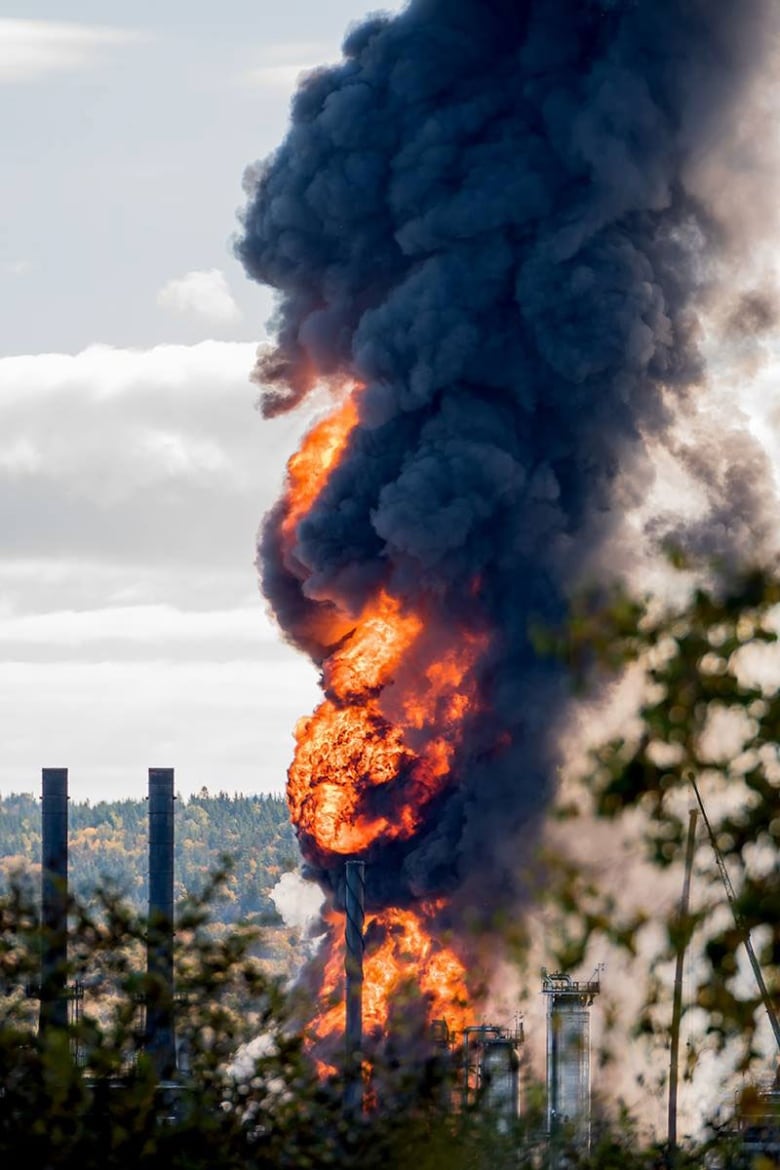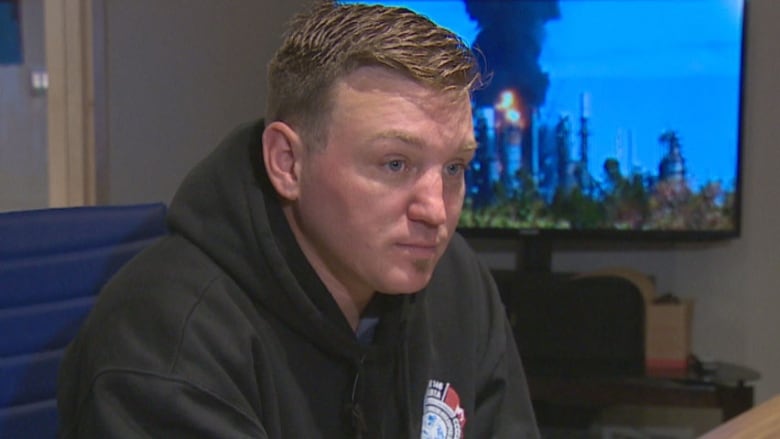
A Texas-based engineer says explosions like the one that happened Monday at the Irving Oil refinery in Saint John almost always result in loss of life.
At least four workers were injured at the refinery in the explosion in the hydrodesulfurization unit, or HDS, where flammable liquids, high pressure and high temperatures are all present in close proximity.

The flames and plume of black smoke towered over the stacks at the refinery in east Saint John on Monday morning. (Submitted by Doug McLean)
Together, those factors can pose significant risk of a major accident, especially during a shutdown, according to Ramanan Krishnamoorti, a petroleum engineer with the University of Houston.
“You’ve got all the ingredients which — if not managed just right — can lead to an explosion,” he said.
“I will be very honest with you: I’m surprised with an incident like this that you had no fatalities.
“It was a close call.”
Removing sulphur
The Saint John refinery can process up to 313,000 barrels per day of crude oil.
All that crude contains impurities like brine, sulphur, and nitrogen compounds.
Sulphur — once it’s burned in fuel and released into the atmosphere — becomes sulphur dioxide, a key contributor to acid rain.
Canada started cracking down on the sulphur content in fuels in the late 1990s, which means removing it is “one of the key things that petroleum refining is meant to do,” said Krishnamoorti, who teaches petroleum engineering and chemical and bio-molecular engineering.

Dr. Ramanan Krishnamoorti teaches petroleum engineering and chemical and bio-molecular engineering at the University of Houston. (Submitted)
According to a 2014 facility profile, the Saint John refinery has five units designed to remove impurities, including the HDS unit.
The diesel treating unit, said Irving Oil spokesperson Kevin Scott on Monday, is “where we believe is the source of the incident and fire.”
Massive tanks
HDS units consist of massive tanks, which can be “20 metres in height, or even taller than that, and maybe five metres in diameter,” said Krishnamoorti.
In 2014, the HDS unit at the Irving Oil Refinery was capable of treating 56,000 barrels of product per day.
In the unit, sulphur in the organic molecules of the fuel is displaced with hydrogen.

A map of the Irving Oil refinery distributed to workers during the 2018 fall turnaround. Workers have said the explosion and fire occurred in Unit 135 of the refinery. (Submitted)
To speed along the chemical reaction, refineries use a catalyst — usually cobalt, nickel or transition metals — and high temperatures between 250 and 350 C.
“You make hydrogen sulfide, which is what rotten eggs smell of, so you don’t want to release that into the environment,” Krishnamoorti said.
“So there is a next step that you go through. You convert that hydrogen sulfide into pure, solid sulphur that you can use for a variety of different purposes.”
Loss of life ‘typical’
On Monday around 10:15 a.m., shortly before a scheduled lunch break, there was a “malfunction” in the HDS unit at the Saint John refinery.
“Typically, when an explosion happens it’s usually pretty uncontrolled,” Krishnamoorti said, “and you do have loss of life with situations like this.
“Startup and shutdown are the two most dangerous times for just about any chemical plant, especially a refinery. Almost every incident that happens, happens when you’re not at steady state. That’s also usually when people are on site.”
Many chemical plants and petroleum refineries have a small permanent staff and many contractors during shutdowns, which might “lead to potential places where you get a compromise of the safety,” Krishnamoorti said,

Boilermaker Terry MacEachern, 36, says he was impressed with how the emergency was handled by the fire department, his union and employer, but he says the fear of the whole refinery blowing up was undeniable and did cause some panic among workers. (CBC)
At the time of Monday’s explosion in Saint John, some of the 3,000 contractors and employees on the site for the shutdown were just getting down from pressure vessels — units that take steam to refine the oil, some of which stand up to 130 feet, almost 40 metres, in the air.
“If it would have been five minutes in the future you would have had 300 to 400 workers walking across a crosswalk that would have been … 50 to 60 yards away from the explosion,” said boilermaker Terry MacEachern.

As of Wednesday afternoon, the area of the fire was still considered a hot zone, according to WorksafeNB. (Submitted by Joseph Comeau)
“If it had been five minutes before people still would have been up in the vessels working right beside it. The timing of the explosion probably saved some lives.”
A crane was heavily damaged in the explosion and subsequent fire.
Chain reaction
The possibility that one explosion at a refinery will ignite another, setting off a chain reaction, is “one of the biggest fears” in the industry, said Krishnamoorti.
“You’ve broken the chain. Then you start to worry where might you back up, where else might become a challenge.”
The next question becomes “how do you isolate this fire, how do you keep it from being just with one unit, and how do you make sure that it doesn’t create a chain reaction.”

Several Saint John residents reported a ‘bed-shaking explosion’ on the east side of the city Monday morning. (Submitted by Joseph Comeau)
On Monday, the area where the fire occurred was completely isolated within a short period of time, according to Scott.
This was a major “success,” according to Krishnamoorti.
“They prevented the chain reaction from happening.”
Leaked material
Saint Johners observed the fire flaring up periodically as late as 9 p.m. Monday.
“The fire did take a number of hours to extinguish with some of the material that had leaked into the area of the unit that was affected,” Scott said.
One possible explanation could be “leakage from a pipeline that allowed combustible material to spread farther out than be just contained in the HDS unit,” said Krishnamoorti, who said 24 hours is a “good period of time” to get such a fire under control.
In Saint John this morning. <br>Workers watch from afar (lower right of screen) as fire crews (small flashing red lights) still douse the blast site 20 hours after the explosion, even though rain is coming down. <br>Not taking any chances with hot spots, it seems. <a href=”https://t.co/iCfapEcyGR”>pic.twitter.com/iCfapEcyGR</a>
—@Brett_CBC
In refineries and chemical processing plants, Krishnamoorti said, there are typically “processes set up where you have multiple barriers — but human factors can defeat these barriers.”
If a barrier failed, Krishnamoorti said, “that might have led to a larger spread of the combustible material and the fire itself.”
I will be very honest with you: I’m surprised with an incident like this that you had no fatalities … It was a close call.– Ramanan Krishnamoorti , University of Houston
When diesel or other combustible material leaks into an area, and it can’t be recovered in any other way, “the safest thing is for it to be burned rather than for it to be a potential ignition spot later on,” Krishnamoorti said.
On Monday afternoon, Scott said, fire crews were “letting that [leaked material] safely extinguish itself with the help of water and the help of foam.”

Worksafe NB is conducting an investigation into the explosion and fire at therefinery and said Wednesday that the company is also collecting data for its own internal process. (CBC)
Investigation underway
The precise cause of Monday’s explosion and fire will not be known until the investigation is completed.
One approach for investigators, Krishnamoorti said, might be to ” look at it [not just] as a process safety issue, but potentially as a human factors issue.”
In refinery incidents, investigators typically look at different factors, including “do you have effective communication across the supply chain … did we go through all of the safety processes to ensure that everything was done appropriately and communicated effectively?”
As of Wednesday afternoon, the site was still considered a “hot zone,” according to WorksafeNB spokesperson Eric Brideau, who said Irving Oil is also collecting data on the cause of the failure.
Given the “technical and complex” nature of the WorksafeNB investigation, it is expected to take two to three months, he said.












